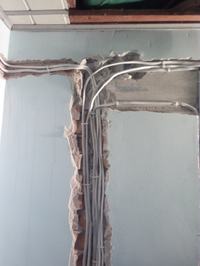Hello Dear Colleagues,
I am an amateur in electrical matters, so I hope that someone will help me at this point. Probably for many it will be a trivial question, but I have a dilemma:
I am to have the electrical installation replaced in a single-family house. The electrician says that the wires on the wall under the plaster must not cross. I have several places in my house where the crossing of the wires to the 220V sockets would avoid dragging the cable around the room (it is up to 100 meters of wires in total). Can the wires actually cross and this is a cardinal error in the art of installation, or is the electrician trying to stretch me a bit?
Thank you very much in advance for your answer.
I am an amateur in electrical matters, so I hope that someone will help me at this point. Probably for many it will be a trivial question, but I have a dilemma:
I am to have the electrical installation replaced in a single-family house. The electrician says that the wires on the wall under the plaster must not cross. I have several places in my house where the crossing of the wires to the 220V sockets would avoid dragging the cable around the room (it is up to 100 meters of wires in total). Can the wires actually cross and this is a cardinal error in the art of installation, or is the electrician trying to stretch me a bit?
Thank you very much in advance for your answer.



